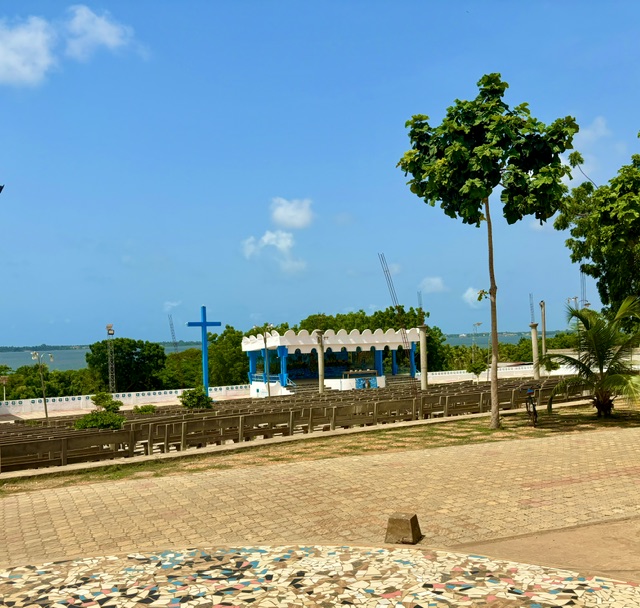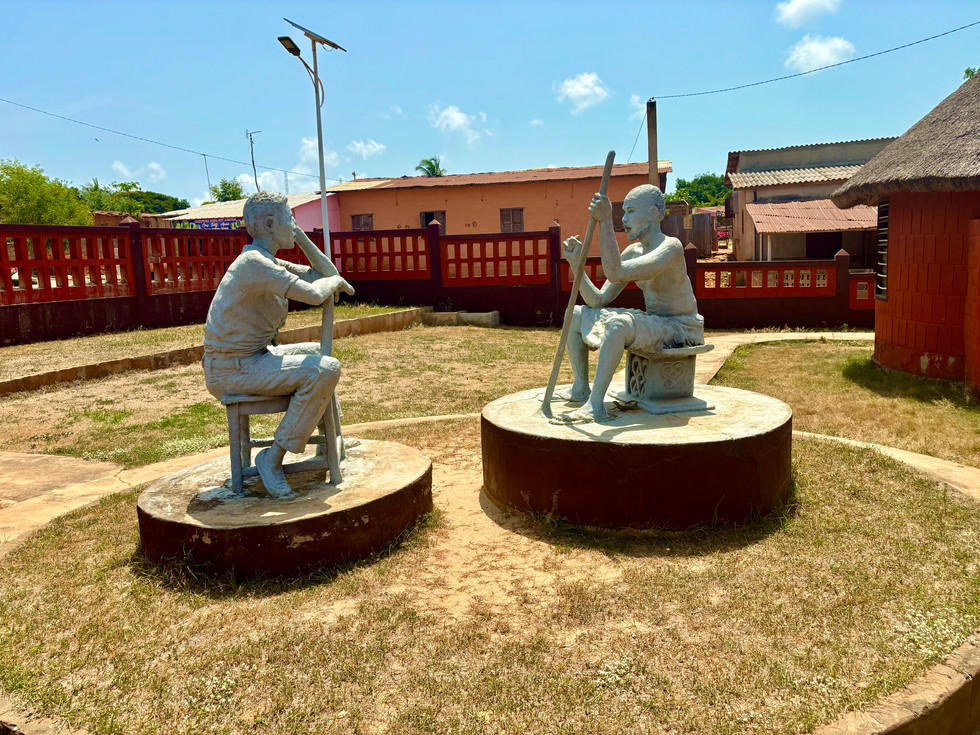In my previous post, I shared some background and history about the West African country of Togo. In that post, I toured the bustling, capital city of Lomé and visited Anéjo, a small, fishing town near the border of Benin.
In this post, I will share what I learned about Togo's culture and religion after visiting the world's largest fetish (probably not the kind you're thinking of) market, the town of Togoville, and Lake Togo, one of the country's most popular tourist destinations.
Lake Togo
First View of Lake Togo
This was my first view of Lake Togo, misnamed because it is actually the country's largest lagoon. It is unique in that it is one of very few that is sourced by both fresh and salt water.
Anéjo, Where Lake Togo Meets the Atlantic
The lagoon is fed by several small rivers and is connected to the Atlantic Ocean by a narrow sandbar, or tombola located in Anéjo, as seen in the video above. (You can read more about my visit to Anéjo, here.)
Lake Togo
Lake Togo is a popular destination for recreational activities such as swimming and boating. The lagoon also provides a food source that the local community and fisherman rely upon for sustenance.
Lake Togo
The portion of Lake Togo that I visited, is surrounded by three of Togo's most culturally and religiously influential towns, as all three all renown for Vodún worship. I'll dive into that shortly, but first, lunch and a boat ride.
Fish with Gari
We ate lunch at a restaurant on the shore, with beautiful views of Lake Togo. I ordered the whole roasted fish, caught just hours earlier. The fish was served with gari piñon, a local speciality, that is also enjoyed in Ghana and Nigeria.
Gari is made with grated cassava that is then fermented. To that is added tomato paste, garlic, ginger, onion and other spices. The cooked mixture is then molded into shape and usually served alongside a protein.

Pirogue to Togoville
Just as we finished lunch, our pirogue arrived. A pirogue is a small, banana shaped boat, used by the local fishermen. We hopped into ours and headed out across Lake Togo to visit Togoville.

Boat Ride To Togoville
Along the way, we saw several other pirogues and fisherman, setting out to work.
Lake Togo Fishing Nets
We also wizzed by fishing nets like these, a type I hadn't seen anywhere before.
Togoville
Togoville
Before I knew it, we had reached the shore of Togoville, originally named Togodo. The country of Togo derives its name from this small town. Togoville is also Togo’s historical center of Vodún, the official religion of Togo, as well as the neighboring country of Benin.
Vodún began as a West African religion that was practiced primarily in Benin, Togo, Ghana and Nigeria. Through the West African slave trade, the religion spread to Haiti as well as Cuba and Louisiana where today, it is known as Voudou, Vodú or Voodoo in each place, respectively.
Courtyard of the Togoville Cathedral
Given that fact, I was surprised to encounter a Catholic church immediately upon our arrival to Togoville. Even more surprising to me was this courtyard, built well after the church, which was erected in 1910 by the Germans as a Presbyterian Church. In 1922, after the French assumed control over Togoland, they converted it into a Catholic cathedral.
The courtyard was constructed much later to host a visit from Pope John Paul II in 1985. If you are wondering why the pope came to visit this small town in Togo, I was too.
Togoville Cathedral
The answer is that in the early 1970's, there was rumored to have been an appearance of the Virgin Mary over the lagoon, near this cathedral. Consequently, Pope John Paul II decided to pay the cathedral a visit.
The cathedral is adorned with stained glass windows and painted murals depicting the life and ministry of Jesus Christ.
Home of Vodún Practitioner
As soon as we left the cathedral for town, my tour guide told me to be on the lookout for flags like the one pictured above. They weren't hard to spot. Apparently, these flags are flown over homes to signal that there is a presence of voodoo in the house. As such, certain protocols must take place prior to entering.
Vodún is an animist religion in which practitioners believe that everything has a spirit. In fact, the word "vodún" means "spirit" in the Fon language of Dahomey (present day, Benin). The vodúns are deities assigned to particular areas, or can also be ancestral spirits.
The primary goal of Vodún is "sevi iwa" ("to serve the spirits"). Voduists therefore venerate their ancestors and revere nature, often emphasizing the power of evil spirits and celebrating possession through divination practices in the hopes of receiving protection, health, power and favor from the vodúns.
Shrine and Tree Dedicated to the Vodún of Twins
Just beyond the cathedral is a forest that is the site of various Vodún rituals and ceremonies for practitioners of Togo's most common religion. For example, Voduists believe that in exchange for tying cloths around this tree and offering sacrifices to it, they will receive twins in childbirth.

Male Fertility Shrine
This shrine is dedicated to the vodún of male fertility, ...
Female Fertility Shrine
... while this shrine is dedicated to the female fertility vodún. Animal sacrifices and blood offerings are either poured on the statue itself, or poured on nearby objects, like the rock that was adjacent to this shrine, covered in blood.
With a palpable uneasiness continually rising in my spirit, and eager to learn about other aspects of Togolese life, I asked that we move on to additional parts of the town's history and culture.
Conflict of Generations
Next, we walked to these statues depicting a young boy and an older gentleman in conversation. My tour guide told me that cumulatively, these statues are called "Conflict of Generations," and symbolize the inherent disagreements and misunderstandings that one generation has with another. Now there's a concept that I think everyone can relate to, no matter their culture or religion.
Togo Barter Market
We walked a little farther into town to visit a traditional, barter market that is only open two days a week at specified times, during which money is not exchanged.

Grain Vendor
Instead, maize, cassava or other grains may be traded for ...
Dried Fish Vendor
... fish or other meats, for example. No matter what the exchange, nobody leaves empty handed.
Monument of Friendship
As we wrapped up the Togoville tour and headed back to the harbor, we passed the Monument of Friendship. The monument was erected in 1984 to commemorate the 100 year anniversary of the treaty the Germans signed with Togo.
Boat Ride Back to Lomé
We arrived back at the Togoville harbor where our pirogue captain awaited.

Lake Togo Fisherman
The trip back to Lomé took us over somewhat choppy waters and past many more fishermen.
Lomé
Marche des Feticheurs
Back in Lomé, we continued our tour of the history and practice of Vodún at the Marche des Feticheurs or Fetish Market.
The Fetish Market is located in Akodessawa, a district of Lomé. This is the largest Voodoo market in the world.
Marche des Feticheurs
The market sells "fetishes," which are objects believed to have supernatural power. If you are thinking charms and crystals, you should think dead animals instead.

Marche des Feticheurs Vendor Booth
Animal bones, pelts and horns abound at this place. I saw cat, monkey and bovine skulls, vulture heads, stuffed owls and the skins of lions, hyenas, tigers, anacondas and cobras, among other things.
Iron Shrine
As in Togoville, I also saw shrines dedicated to specific vodún. This one for example, collects offerings from anyone in the iron profession. Animal sacrifices are brought here and prayers are spoken in the hopes that the supplicant's business will prosper.
Animal Skulls
A Vodún priest was also on site at the Marche des Feticheurs. For a price (I think it was 20,000 CFA), he offered to chant an incantation over me and prescribe any medications I may need. I politely gave the offer a hard miss and a strong no.
With that, we headed back to the hotel. While laughing, my tour guide and driver told me that of all the tourists they have ever brought to the market, my visit was the shortest.
And on that note, I want to thank Ashanti African Tours, but especially Isaac and Richard. I am so blessed to have been paired with you both as my tour guides, and I am grateful that we are still in touch. It's seldom that three strangers spend 10 days together, get along so well and laugh so much. Thank you for taking such good care of me in Togo and Ghana (which I promise to write about soon).
Spaghetti with Meat Sauce
I arrived back at my hotel in time for this dinner, my last meal in Togo. Upon asking for a local recommendation, my server suggested a bowl of spaghetti, which surprised me until I took a bite.

This was spaghetti with a Togolese twist, and it was great. It was made with ground goat and lamb, instead of beef and pork, as well as other local spices, most of which were unfamiliar to my palate, other than cinnamon and black pepper.
Creme Caramel Ice Cream
To make sure my Togo trip ended on a sweet note, my server brought out this complimentary bowl of ice cream that was almost custard-like in its consistency, and very decadent in taste. Over dessert and throughout my meal, I prayerfully reflected on the day's spiritual experiences which brought to mind the last line in a Bible verse, which I adhere to. The verse is from the book of Joshua, and it reads:
"But if serving the Lord seems undesirable to you, then choose for yourselves this day whom you will serve, whether the gods your ancestors served beyond the Euphrates, or the gods of the Amorites, in whose land you are living. But as for me and my household, we will serve the Lord.”
That completes my trip to Togo. I am grateful to have visited and learned so much. I hope to return to Africa again soon. It is a continent rich with history and culture, as well as warm and welcoming people.





































